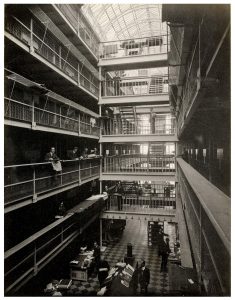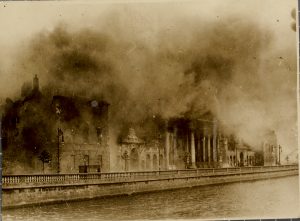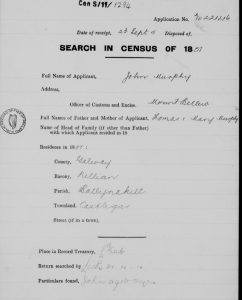The burning of the Public Record Office in Dublin in 1922 is the sole reason why we spend so much research time on ridiculously bitty little scraps of half-records. We’re like archaeologists trying to reconstruct branches of humanity from a piece of fossilised jawbone. Except that we also want to know who the jawbone’s parents were, who it married and the names of all its children.


The 1841 and 1851 census search forms are some of the most peculiar of these fragments. They came into existence because of the introduction of the Old Age Pension in early 1909. To qualify for the princely sum of five shillings a weeks, applicants had to be “of good character”, have an annual income of less than £31-10s and demonstrate that they were seventy or more.
But the state only began to register Irish births in 1864, more than twenty years after the relevant period. So a system evolved to get the PRO to use the 1841 and 1851 census returns for proof of age. Based on an address and parents’ names supplied by the applicant, either directly to the PRO or through an official of the Pensions Board based locally (Customs and Excise men in an unusually popular role), the Office would search the returns and confirm the necessary age.
After we went and blew up all the originals (thank you, Ernie O’Malley), only the PRO search forms survive for most areas. They are useful primarily for the information submitted by the applicants, but sometimes the search results include scribbled summaries of the others recorded on the form. In the sample 1841 image, John Murphy of Castlegar, Ballynakill Co. Galway has his parents confirmed as Thomas and Mary, but the “particulars found” include the fact that they married in 1833 and others in the household were Elenor (5), Patt (4) and Biddy (2). In the 1851 search, however, only “John aged 20” is noted.


At their best, then, they can come close to the full original. But how many exist? There are 32,472 forms in total for the Republic and 3,568 for areas now in Northern Ireland. This represents less than 1% of the households covered in 1841 and 1851 As with so much of Irish genealogy, luck is an essential ingredient.
The forms for the Republic are online at The National Archives of Ireland. The search interfaces at ancestry.com and FindMyPast.ie are better, with FindMyPast especially useful in the way it allows the easy retrieval of all forms from a particular parish. FindMyPast is also completely free. The FamilySearch version won’t let you look at the images outside a Family History Centre, for reasons only the LDS know.
The Northern Irish forms are on microfilm in PRONI and published by Josephine Masterson as Ireland 1841/1851 Census Abstracts (Northern Ireland) (Baltimore, MD: GPC., Inc., 1999), transcribed on ancestry.com.
I found the forms from Clogher parish County Tyrone, years ago through the FHL. They have been scanned by others and are online. What was interesting is that the oldest sister Ann applied in 1916 and then the oldest brother Patrick in 1918 and were both denied. They did provide a lot of details in their applications; names of parents and grandparents, synonym of the surname(McGuigan and/or Goodwin), townland of Tulnafoile(Tullanafoile). The second sister applied in 1920 and added the request to expand the search to include the adjacent downland, Kilnaheery. Third time was the charm and both she and Ann received the pensions until they died in 1925 and 1931. Not sure why Patrick did not re-apply but he died in 1921. The most basic of details were listed that in 1851 Ann was 5, Patrick 3 and Sarah 1. I wish it would have listed the whole household as I am trying to establish if there were older siblings named Hugh and Owen. I also would like to know what became of the records for those who did receive an old age pension and the details that would indicate when the pensioner died. Governments love papers, they have to be somewhere.
Hi John:
I just read a blog post by Damien Shiels last week that noted that many of those seeking U.S. Civil War pensions used the Census forms and some of these survive in the Civil War application files. For those lucky enough to find one for an ancestor, the information can be priceless. Thanks for this post.
I think these forms are wonderful. Of the ones I’ve used, my favourite is the application from an unfortunate man whose application was refused (fair enough, he wasn’t in the 1851 census), but he provided an enormous mount of information including the fact that his mother had remarried after his father’s death, and that allowed me to flesh out the family considerably, and also to place him in the family, because up to that point he was a singleton in the 1911 census.
But they can be so terribly tantalizing.
Hi John,
Thanks for the article. Interesting source. Every scrap helps!
Re: Census returns. Most people are aware of the destruction of the records in 1922. However many people are unaware of the fact that several of the late 19th Century records had already been destroyed by that stage. As a novice in genealogical matters, I only first heard of this two years ago. Anyone I’ve asked in historical circles etc. Since assumed that the fire burned all census records.
Have you ever written on this topic or has any other historian/genealogist written on to how and why these Census Records were destroyed by the Government?
Thanks again for your interesting articles.
My delightful lucky find was my Crawley family in Cloontarsna in Co. Roscommon the 1851 census. It gave the parents’ marriage year (a year out – not too bad for the times), the mother’s maiden name, the ages of all six of their children that were born at that time, no deaths and no absents. I had all of this information but I had been going on the assumption that the people recording themselves as Crolly, Crotty, Crawly and Crawley were the same people so at least it confirmed it. It was also interesting that I had no record of a James Crawley who was the applicant as a child of the couple even though I had births from 1841 to 1859 with a three year gap being the longest for the youngest. Either this person thought there was a James in this family and was hoping to get his pension or else there was a James. The interesting thing about the youngest child Michael’s baptism was that his father was recorded as James instead of Michael. It is possible that the name of the son and father were mixed up when recording their names. It gives me something to think about anyway.
I would have loved to find a census for my Conneallys in Williamstown since I can’t find the names of parents of the equivalent generation of the Crawley parents. Another nice one would have been McDonaghs in Ballinagare but alas.
Very interesting. My paternal grandmother was a Crolly and some of the family were called Crawley.
These forms are a wealth of information. I was able to find (finally) my 3x G Grandmother’s maiden name on it. It also told me where the applicant my 2x great grandfather was living when he applied which led to finding a sister at that address.
My Great Grandmother applied, and the resulting census information provided me with the first name of my Great Great Grandmother, and a Great Grand Uncle that I didn’t have in my tree (and his name may be a clue to his Grandfather’s first name….if they were following the traditional naming pattern). A true gold mine! The local National School Teacher filed the application for my Great Grandmother in rural Connemara, Co Galway.
I’m a bit confused as to what of the above-mentioned items are available.
Are the application forms that the person submitted to be considered for the pension still available, or just the results forms?
I have a great-great grandfather who may have been the one on a results form, but without some kind of identifying information clarifying who the submitter was, I cannot be sure it is him. His is a fairly common name, and there are several others with the same name in his “neighborhood” in 1841/1851.
The results form information I saw also contradicts other evidence (admittedly scanty) I’ve ever gotten of his parentage.
I am also speaking of County Antrim, so I know things might be different for NI. The only thing I can easily/quickly access is the transcriptions on Ancestry.com – nothing like seeing the actual results forms on Find My Past.
Does anyone know if PRONI has any plans to digitize the actual results forms and put them online? That would be at least a step better.
Interesting. my maternal grandmother was a Crolly but some of the family used the name Crawley. Fr James Crolly was present at the Christening of the Prince Imperial in Paris , about 1850, but I have not been able to trace the family records in Ireland
I was able to jump two generations because of this form. Also, discovered a female ancestor whom nobody ever heard of which opened up a new branch. I just wish there were more.
Several years ago, when I returned from my research in Dublin I wonder what I could investigate in the US that would shed some light on ordinary people in Ireland. I stumbled upon the correspondence files of the US Department of State, Consulates in Dublin, Cork and Belfast.
One example, I found letters dated 4 April 1917 list 4 Watson families info from the 1851 Census, Parish of Drum, Barony of Athlone, Co Roscommon.
Many of the other saved documents are “bitty little scrap of paper” tell stories of many of the everyday people trying to connect with relatives.